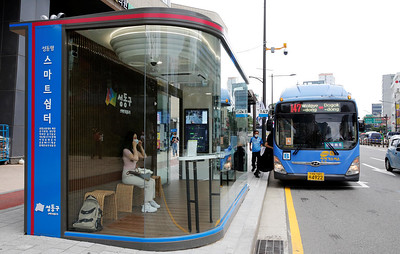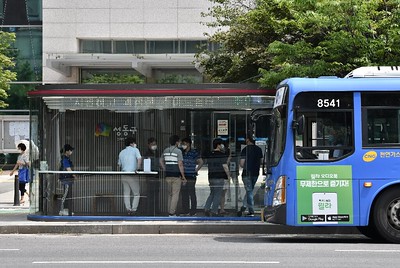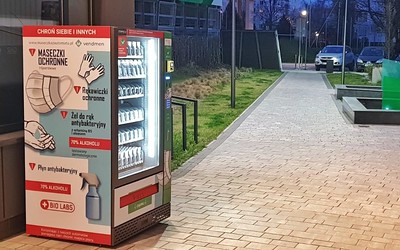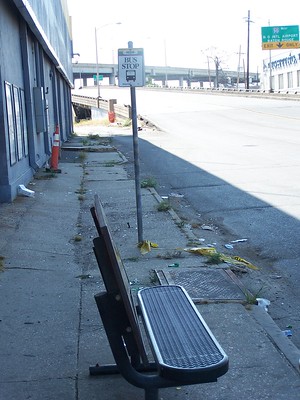That district happens to have some exciting streetscape projects going on, but they didn't think about this so much in terms of branding with other elements of their program. Instead they were focused on public art.
-- Streetscape Playbook, Memphis Medical District Collaborative
This isn't a surprise. Most US bus transit systems haven't fully thought through bus transit as a "design product" ("Branding's (Not) all you need for transit"). I haven't read this thesis but need to give it a skim:
-- "Reconsidering bus shelters: design interventions for public space," Aliah Candioty Werth, Vassar College
The query reminded me of an experiment in Singapore, Project Bus Stop, a one-off experiment concerning bus stops both as "social spaces" and as elements of a "smart city."
I wrote about it a few years ago, but somehow didn't include this graphic from the Straits Times article on the project. DPA Architects were the lead. The bus station is still up but they've taken out various smart city elements as they are no longer supporting it.

The attractively designed station incorporated a little free library, a swing, bicycle parking, charging stations for smartphones, wifi, and other elements.

Transit systems and covid. While looking up some links for the Singapore project, I came across articles ("South Korea installs anti-virus bus shelters with temperature sensors and UV lamps," Guardian) about how a district in Seoul has erected a number of experimental bus shelters aimed to reduce covid virus spread, by refusing entry--the bus shelter is completely enclosed--to people with a temperature greater than 99.5.

A woman wears a mask inside a glass-covered bus stop in which a thermal imaging camera, UV sterilizer, air conditioner, CCTV and digital signage are set, to avoid the spread of COVID-19 in Seoul, South Korea, August 14, 2020. REUTERS/Heo Ran.
But besides anti-disease features like bathing the shelter in UV light, the stations are also super design forward ("Using the Purple Line to rebrand Montgomery and Prince George's Counties as Design Forward") and an illustration of how striking/quality design of transit infrastructure helps to positively brand transit in a cohesive way.
It appears as if transit isn't a key point for virus spread ("Is the Subway Risky? It May Be Safer Than You Think," New York Times," ), although research is not yet definitive. Definitely ventilation systems will need to be improved in order to reduce the likelihood of spread, both on rail transit and buses. Opening windows on buses helps a lot in the meantime.
But entry checks, vending machines for masks, and other measures can reduce people's fears.

A bus shelter designed to protect passengers from monsoon rains, summer heat and coronavirus in Seoul, South Korea. Photograph: Jung Yeon-Je/AFP/Getty Images.

Aleksander Wąsik, president of the Polish Vending Association, coordinated the launch of “maseczkomat” (mask-o-mat) machines. The new devices sell a variety of products, including three-layer medical masks, sold for 8.80 zloty, nitrile gloves for 2.50 zloty, and antibacterial gel for either 13.90 zloty a bottle or 4.50 zloty a sachet. Vendmen, the firm producing the machines, says that eight have been rolled out so far, with two in Warsaw and six in Kraków. Plans are underway to install more in locations across Poland over coming weeks. Photo: Spółdzielnia Mieszkaniowa “Służew nad Dolinką”/Facebook.
Transit shelters as marketing devices. I make the point that transit shelters are a key marketing touchpoint for transit, not just for existing riders, but for people who see the shelters, use information presented by them. The shelters are a marketing message.
And if a community has crappy bus shelters (and/or crappy street furniture more generally), it communicates very clearly whether or not public spaces are seen as valuable and important.
I use this photo of a no longer extant DC bus shelter as an example

as well as this bus stop from New Orleans.

At the time I took this photo, this was a key transfer point between bus service from the airport and Downtown. It definitely communicated "don't take the bus to and from the airport."
Street furniture as a network. The thread also made me think about street furniture as an integrated network. I've mentioned it before, but it can not be overemphasized. The ensemble matters.
No comments:
Post a Comment